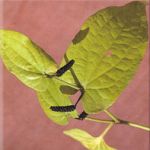| Common Name: |
Kana |
| Other Names: |
Bi Bo, Indian Long Pepper, Jaborandi Pepper, Long Pepper, Magadhi Pippali |
| Botanical Name: |
Piper longum |
| Genus: |
Piper |
| Family: |
Piperaceae |
| Native Location: |
S and E India |
| Cultivation: |
Rich, well-drained soil in light shade and high humidity (P. longum, P. nigrum). Deep, rich soil, including heavy clay, ample moisture and shade (P. betle, P. cubeba). P. auritum thrives in full sun. Well-drained, stony soil, with ample water and humidity, in sun (P. methysticum). Plants are usually grown on frames. Remove weak of congested stems in late winter or early spring before new growth begins. For optimum fruiting (P. nigrum), cut back young plants to 30cm (12in) several times a year to stimulate growth of shoots, retaining the ten strongest, and tying in at each node. Mature vines are pruned regularly to 4m (12ft). Susceptible to fungal root rot, pepper weevil, and pepper flea beetle. |
| Propagation: |
By seed sown at 20-24°C (66-75°F); by semi-ripe cuttings in summer. |
| Harvest: |
Leaves are picked as required (P. auritum), blanched in the dark, often pressed together, and dried for extracts or to use whole (P. betel). Roots are lifted as required, usually from plants about 2m (6ft) tall, and used fresh, or dried for use in decoctions, liquid extracts, powders, and tablets (P. methysticum). Fruits are picked unripe and distilled for oleo-resin and oil, or dried for use in liquid extracts, powders and tinctures (P. cubeba). Fruit clusters are picked unripe and dried for use whole, ground or in decoctions (P. longum). Fruits of P. nigrum are picked unripe and used fresh, pickled (green peppercorns), and dried (green and black peppercorns); or ripe, and retted for eight days before drying (white peppercorns); black peppercorns are ground or decocted for medicinal use. |
| Height: |
3m (10ft) |
| Width: |
5-6m (15-20ft) |
| Hardiness: |
Min. 15-18°C (59-64°F) |
| Parts Used: |
Fruits (bi ba) |
| Properties: |
An aromatic, hot, stimulant herb that improves digestion and has decongestant, antibacterial, antifungal, and analgesic effects. |
| Medicinal Uses: |
Internally, in traditional Chinese medicine, for stomach chills, vomiting, acid regurgitation, headache, and rhinitis; and, in Ayurvedic medicine, for colds, asthma, bronchitis, arthritis, rheumatism, lumbago, sciatica, epilepsy, indigestion, and gas. Externally, in traditional Chinese medicine for toothache. Combined with P. nigrum and Zingiber officinale (See, Ginger) in trikatu, an Ayurvedic remedy for cold conditions, and in chyavanaprash, a rejuvenating tonic.
To treat toothache, headache, cough, diarrhea, heartburn, psoriasis, and tuberculosis; to stimulate menstrual flow; to improve digestion. |
| Drug Interactions: |
| Taking Indian long pepper with these drugs may increase absorption and blood levels of the drug: |
| Phenytoin, (Dilantin, Phenytek) |
Propranolol, (Inderal, InnoPran XL) |
Theophylline, (Elixophyllin, Theochron) |
|
| Lab Test Alterations: |
May increase serum concentration of phenytoin, propranolol, and theophylline. |
| Supplement Interactions: |
Increased bioavailability of sparteine, a constituent of Scotch Broom that causes depression of the nervous system and can be toxic in large amounts. |
| Culinary Uses: |
Dried unripe fruits are used in curries and pickles; also to adulterate black pepper, and as an ingredient of Moroccan spice blend, ras el hanout. |
| Bibliography: |
Encyclopedia of Herbs by Deni BrownCopyright © 1995, 2001 Dorling Kindersley Limited. pp. 319-321
The Essential Herb-Drug-Vitamin Interaction Guide by Geo. T. Grossberg,MD and Barry Fox,PhD Copyright©2007 Barry Fox,PhD Pp.282-283 |

